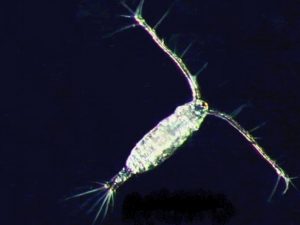Study: Dispersant, UV Radiation Increase Oil Spill Impacts on Zooplankton but Food Web Interactions may Reduce Them
– July 8, 2014
Researchers from the University of Texas Marine Science Institute, including students from California and China, assessed impacts of crude oil, dispersant, and natural phenomena on zooplankton from the Gulf of Mexico.
They found that, at the oil-dispersant ratio commonly used to treat spills, dispersant and dispersant-treated oil were over twice as toxic as crude oil alone and that UVB radiation further increased crude oil toxicity to zooplankton. They found bioaccumulation of selected polycyclic aromatic hydrocarbons (PAHs) in zooplankton; however, the presence of marine protozoans reduced PAH bioaccumulation in copepods and may mitigate harmful impacts and subsequent transfer to the food chain. The team published their findings in the June 2013 Public Library of Science (PLOS) ONE: Interactions between zooplankton and crude oil: Toxic effects and bioaccumulation of polycyclic aromatic hydrocarbons.
Zooplankton play an important role in marine food web dynamics; however, they are vulnerable to pollutants. Zooplankton also play a role in influencing the fate of toxins by absorbing, transforming, and eliminating contaminates. These complex interactions may potentially impact the larger marine environment. For this study, researchers focused on natural mesozooplankton assemblages and on the copepod Acartia tonsa, a widespread and dominant planktonic species in the Gulf of Mexico. The team used Light Louisiana sweet crude oil, considered to have similar chemical composition and toxicity to Deepwater Horizon oil, and Corexit 9500A in experiments to better understand the interactions between these pollutants and zooplankton.
Zooplankton samples were collected from surface waters in northern Gulf of Mexico and in the Aransas Ship Channel (Port Aransas, TX). Researchers conducted ship-, shore-, and laboratory-based crude oil exposure experiments to investigate the (1) crude oil effects on survival of and PAH bioaccumulation in mesozooplankton; (2) lethal effects of dispersant and dispersant-treated oil on mesozooplankton; (3) influence of UVB radiation/sunlight exposure on dispersed crude oil toxicity; and (4) role of marine protozoans on sublethal effects of crude oil and PAH bioaccumulation in the copepod Acartia tonsa.
Results showed that zooplankton are “especially vulnerable to acute crude oil exposure” and that “dispersant and dispersant-treated oil were 2.3 and 3.4 times more toxic, respectively, than crude oil alone.” The team reported that after 48 hours of exposure, “Corexit 9500A alone produced nearly 50% mortality in natural mesozooplankton communities at concentrations of 0.25 ppm, which is more than one order of magnitude lower than lethal concentrations commonly observed in other marine animals exposed to dispersant.”
The sunlight experiments showed that “UVB radiation increased the lethal effects of dispersed crude oil to coastal mesozooplankton communities by 35%.” Researchers suggest that photo-enhanced toxicity is relevant in evaluating oil spill impacts, particularly for zooplankton that “live in the upper layers of the water column and in intertidal and shallow coastal areas.”
In crude oil exposure experiments, the total PAH concentration in copepods was “between 2.5 – 10 times higher than those not exposed.” The team found that concentrations of fluoranthene, phenanthrene, pyrene, chrysene were “significantly higher in copepods exposed to crude oil than in copepods not exposed to crude oil,” suggesting selective bioaccumulation.
Results showed that crude oil reduced rates of egg production and egg hatching. However, the team observed “differences in sublethal effects (reduced egg production, delayed hatching) and bioaccumulation of PAHs depending on the absence or presence of protozoan Oxyrrhis marina in the water.” The reduction in egg production rates was lessened (1.42 times) as was the reduction in egg hatching rates (1.7 times). PAH levels were reduced in copepods (1.6 times) and fecal pellets (1.1 – 18.3 times depending on the PAH) compared to control treatments. Given the overall reduction of PAH levels, the team suggested that competing grazers such as this protozoan “could remove oil from the water column by both passive uptake of dissolved petroleum hydrocarbons and by ingestion of oil droplets.” Authors also suggest that fecal pellets contaminated with crude oil may “play a relevant role in the distribution of petroleum hydrocarbons in the sea.”
In their discussions, the researchers acknowledge that the impacts from oil spills on planktonic communities “depends on many physical, chemical and biological factors,” and effects would “vary depending on the circumstances of each spill.” They call for “further experiments that mimic the natural environment” to accurately evaluate the toxic effects and PAH bioaccumulation in zooplankton. Because their findings suggest that zooplankton are “highly sensitive” to Corexit 9500A, they “recommend the use of representative planktonic copepods [such as Acartia tonsa] as a target species to evaluate the impact of crude oil and oil spill chemical cleanup operations in marine environments.”
The study’s authors are Rodrigo Almeda, Zoe Wambaugh, Zucheng Wang, Cammie Hyatt, Zhanfei Liu, and Edward J. Buskey (PLOS ONE, 2013 8(6): e67212).
************
This research was made possible in part by a grant from theGulf of Mexico Research Initiative (GoMRI) to the Dispersion Research on Oil: Physics and Plankton Studies (DROPPS) consortium. Other funding sources included the National Oceanic and Atmospheric Administration NA07- NOS4780225 and the National Science Foundation OCE- 1062745.
GoMRI is a 10-year independent research program established to study the effect, and the potential associated impact, of hydrocarbon releases on the environment and public health, as well as to develop improved spill mitigation, oil detection, characterization and remediation technologies. An independent and academic 20-member Research Board makes the funding and research direction decisions to ensure the intellectual quality, effectiveness and academic independence of the GoMRI research. All research data, findings and publications will be made publicly available. The program was established through a $500 million financial commitment from BP. For more information, visit https://gulfresearchinitiative.org/.
© Copyright 2010- 2017 Gulf of Mexico Research Initiative (GoMRI) – All Rights Reserved. Redistribution is encouraged with acknowledgement to the Gulf of Mexico Research Initiative (GoMRI). Please credit images and/or videos as done in each article. Questions? Contact web-content editor Nilde “Maggie” Dannreuther, Northern Gulf Institute, Mississippi State University (maggied@ngi.msstate.edu).






